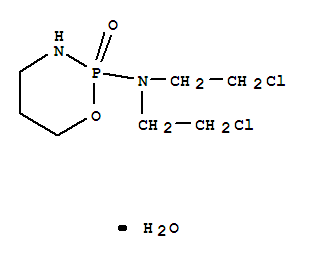Cyclophosphamide monohydrate cas no:6055-19-2
Synonyms: 2H-1,3,2-Oxazaphosphorin-2-amine,N,N-bis(2-chloroethyl)tetrahydro-, 2-oxide, monohydrate (9CI);2H-1,3,2-Oxazaphosphorine, 2-[bis(2-chloroethyl)amino]tetrahydro-, 2-oxide,monohydrate (8CI);2-[Bis(2-chloroethyl)amino]tetrahydro-2H-1,3,2-oxazaphosphorine-2-oxidemonohydrate;Endoxanmonohydrate;2H-1,3,2-Oxazaphosphorin-2-amine,N,N-bis(2-chloroethyl)tetrahydro-, 2-oxide, hydrate (1:1);
NameCyclophosphamide monohydrate
CAS6055-19-2
Synonyms2H-1,3,2-Oxazaphosphorin-2-amine,N,N-bis(2-chloroethyl)tetrahydro-, 2-oxide, monohydrate (9CI);2H-1,3,2-Oxazaphosphorine, 2-[bis(2-chloroethyl)amino]tetrahydro-, 2-oxide,monohydrate (8CI);2-[Bis(2-chloroethyl)amino]tetrahydro-2H-1,3,2-oxazaphosphorine-2-oxidemonohydrate;Endoxanmonohydrate;2H-1,3,2-Oxazaphosphorin-2-amine,N,N-bis(2-chloroethyl)tetrahydro-, 2-oxide, hydrate (1:1);
EINECS(EC#)200-015-4
Molecular FormulaC7H15Cl2N2O2P
Molecular Weight279.13
AppearanceWhite to Off-White Solid
storage temp2-8°C
Globally Harmonized System of Classification adn Labelling of Chemicals(GHS)
Hazardclass6.1
Hazard T: Toxic;
Risk R25;R36/37/38;R45;R46;R61
Safety
Hazard Codes:  T
T
Risk Statements: 45-25-61-46-36/37/38-23/24/25
R45:May cause cancer.
R25 :Toxic if swallowed.
R61:May cause harm to the unborn child.
R46:May cause heritable genetic damage.
R36/37/38:Irritating to eyes, respiratory system and skin.
R23/24/25:Toxic by inhalation, in contact with skin and if swallowed.
Safety Statements: 53-45-37/39-26
S53:Avoid exposure - obtain special instructions before use.
S45:In case of accident or if you feel unwell, seek medical advice immediately (show the label whenever possible.)
S37/39:Wear suitable gloves and eye/face protection.
S26: In case of contact with eyes, rinse immediately with plenty of water and seek medical advice.
RIDADR: UN 3464 6.1/PG 3
WGK Germany: 3
RTECS: RP6157750
F: 10
HazardClass: 6.1
PackingGroup: II
Confirmed human carcinogen. Poison by ingestion and intravenous routes. Experimental reproductive effects. Mutation data reported. When heated to decomposition it emits toxic fumes of Cl−, POx, and NOx.
| Organism |
Test Type |
Route |
Reported Dose (Normalized Dose) |
Effect |
Source |
| dog |
LD50 |
intravenous |
40mg/kg (40mg/kg) |
|
Deutsche Medizinische Wochenschrift. Vol. 83, Pg. 453, 1958. |
| dog |
LD50 |
oral |
44mg/kg (44mg/kg) |
BEHAVIORAL: SOMNOLENCE (GENERAL DEPRESSED ACTIVITY)
BEHAVIORAL: ATAXIA
GASTROINTESTINAL: NAUSEA OR VOMITING |
Toxicology and Applied Pharmacology. Vol. 4, Pg. 324, 1962. |
| guinea pig |
LD50 |
intravenous |
400mg/kg (400mg/kg) |
|
Deutsche Medizinische Wochenschrift. Vol. 83, Pg. 453, 1958. |
| mouse |
LD50 |
intravenous |
275mg/kg (275mg/kg) |
|
Toxicology and Applied Pharmacology. Vol. 4, Pg. 324, 1962. |
| mouse |
LD50 |
oral |
350mg/kg (350mg/kg) |
BEHAVIORAL: ATAXIA
KIDNEY, URETER, AND BLADDER: URINE VOLUME INCREASED
BLOOD: HEMORRHAGE |
Toxicology and Applied Pharmacology. Vol. 4, Pg. 324, 1962. |
| rabbit |
LD50 |
intravenous |
130mg/kg (130mg/kg) |
|
Deutsche Medizinische Wochenschrift. Vol. 83, Pg. 453, 1958. |
| rat |
LD50 |
intraperitoneal |
121mg/kg (121mg/kg) |
|
Farmacia Vol. 18, Pg. 409, 1970. |
| rat |
LD50 |
oral |
94mg/kg (94mg/kg) |
BEHAVIORAL: ATAXIA
KIDNEY, URETER, AND BLADDER: URINE VOLUME INCREASED
BLOOD: HEMORRHAGE |
Toxicology and Applied Pharmacology. Vol. 4, Pg. 324, 1962.
|


 T
T